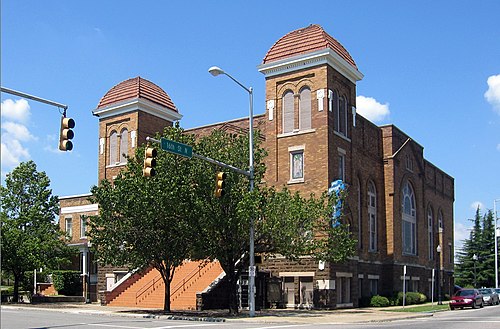16th Street Baptist Church | |
 16th Street Baptist Church in September 2005 | |
| Location | Birmingham, Alabama |
|---|---|
| Coordinates | 33°30′59.69″N86°48′53.26″W / 33.5165806°N 86.8147944°W /33.5165806; -86.8147944 |
| Built | 1911 / 1873 |
| Architect | Wallace Rayfield; Windham Bros. Construction Co. |
| Architectural style | Romanesque |
| NRHP reference No. | 80000696 |
| Significant dates | |
| Added to NRHP | September 17, 1980[2] |
| Designated NHL | February 20, 2006[3] |
| Designated ARLH | June 16, 1976[1] |
The16th Street Baptist Church is aBaptist church inBirmingham,Alabama, United States.
In 1963, thechurch was bombed byKu Klux Klan members. The bombing killed four young girls in the midst of theCivil Rights Movement. The church is still in operation and is a central landmark in theBirmingham Civil Rights District. It was designated as aNational Historic Landmark in 2006.[3][4] Since 2008, it has also been on the UNESCO list of tentativeWorld Heritage Sites.[5]

The 16th Street Baptist Church was organized as theFirst Colored Baptist Church of Birmingham in 1873. It was the first black church to organize in Birmingham, which was founded just two years before. The first meetings were held in a small building at 12th Street and Fourth Avenue North. A site was soon acquired on 3rd Avenue North between 19th and 20th Street for a dedicated building. In 1880, the church sold that property and built a new church on the present site on 16th Street and 6th Avenue North. The new brick building was completed in 1884 under the supervision of its pastor,William R. Pettiford,[6] but in 1908, the citycondemned the structure and ordered it to be demolished. Pettiford was pastor from 1883 to 1904.
The present building, a "modifiedRomanesque andByzantine design" by the prominent black architectWallace Rayfield, was constructed in 1911 by the local black contractor T.C. Windham. The cost of construction was $26,000. In addition to the main sanctuary, the building houses a basement auditorium, used for meetings and lectures, and several ancillary rooms used for Sunday school and smaller groups.
As one of the primary institutions in the black community, the 16th Street Baptist Church has hosted prominent visitors throughout its history.W. E. B. Du Bois,Mary McLeod Bethune,Paul Robeson andRalph Bunche all spoke at the church during the first part of the 20th century.

During the civil rights movement of the 1960s, the 16th Street Baptist Church served as an organizational headquarters, site of mass meetings and rallying point for African Americans protesting widespread institutionalized racism in Birmingham, Alabama, and the South. The ministersFred Shuttlesworth, who was the chief local organizer,Southern Christian Leadership Conference (SCLC) leaderMartin Luther King Jr., and SCLC leaderJames Bevel, who initiated the Children's Crusade and taught the studentsnonviolence, were frequent speakers at the church and led the movement.
On Sunday, September 15, 1963,Thomas Blanton,Bobby Frank Cherry andRobert Edward Chambliss, members of theKu Klux Klan, planted 19 sticks ofdynamite outside the basement of the church. At 10:22 a.m., they exploded, killing four young girls – Addie Mae Collins, Carole Robertson, Cynthia Wesley and Denise McNair. Twenty-two other victims suffered injuries. They were there preparing for the church's "Youth Day". A funeral for three of the four victims was attended by more than 8,000 mourners, white and black, but no city officials.
This was one of a string of more than 45 bombings within the decade. The neighborhood of Dynamite Hill was the most-frequently targeted area during this time. The bombing of the 16th Street Baptist Church increased Federal involvement in Alabama. President Johnson signed the1964 Civil Rights Act into law the following year; and in 1965 theVoting Rights Act was passed, makingliteracy tests and poll taxes illegal.
Following the bombing, more than $300,000 in unsolicited gifts were received by the church and repairs were begun immediately. The church reopened on June 7, 1964. A stained glass window depicting ablack Jesus, designed byJohn Petts, was donated by citizens of Wales and installed in the front window, facing south.[7]

The church was added to theAlabama Register of Landmarks and Heritage on June 16, 1976.[1] On September 17, 1980, it was added to theNational Register of Historic Places. In 1993, a team of surveyors for theHistoric American Buildings Survey executed archival quality measured drawings of the church for theLibrary of Congress. Because of its historic value on a national level in the moral crusade of civil rights, the church was officially designated aNational Historic Landmark on February 20, 2006, by theUnited States Department of the Interior. On January 1, 2008, the US Government submitted it to UNESCO as part of an envisaged future World Heritage nomination and as such it is on UNESCO's tentative list ofWorld Heritage Sites.[5] In 2017, the church became part of the newly createdBirmingham Civil Rights National Monument.[8]
As part of theBirmingham Civil Rights District, the 16th Street Baptist Church receives more than 200,000 visitors annually. Though the current membership is only around 500, it has an average weekly attendance of nearly 2,000. The church also operates a largedrug counseling program. The current pastor is the Reverend Arthur Price. Across from the church atKelly Ingram Park is theBirmingham Civil Rights Institute, which plans events that teach and promote the history of human rights.
The 16th Street Baptist Church engaged in a $3 millionrestoration of the building in the first decade of the 21st century. Persistent water damage problems and exterior brick facing failure were addressed. The first phase of restoration, mainly below-grade waterproofing, was completed in 2007, followed by work on the exterior masonry. Additional funds were sought to handle unexpected problems uncovered during the work and to provide for ongoing physical maintenance.
{{cite book}}:ISBN / Date incompatibility (help)